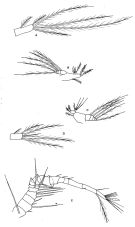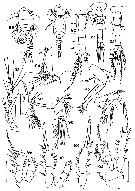|
|
 |
|
Cyclopoida ( Order ) |
|
|
|
Oithonidae ( Family ) |
|
|
|
Oithona ( Genus ) |
|
|
| |
Oithona dissimilis Lindberg, 1940 (F,M) | |
| | | | | | | Syn.: | Oithona dissimilis oceanica Lindberg, 1947;
O. hebes : Wellershaus, 1969 (p.276, figs.F,M) | | | | Ref.: | | | Lindberg, 1940 (p.519, Descr.F,M, figs.F); Sewell, 1948 (p.430); Lindberg, 1955 a (p.467: Rem.); Gonzalez & Bowman, 1965 (p.270, Rem.); Ferrari, 1977 (p.400, Redescr., figs.F, M, Rem.); Ueda, 1985 (p.125); Nishida, 1985 (p.138, 141); 1985 a (p.142, 143); Chihara & Murano, 1997 (p.937, Pl.198,202: F,M); McKinnon, 2000 (p.108, Rem.); Cornils & Heckmann, 2015 (p.243, Fig. 2, molecular biology) |  issued from : F.D. Ferrari in Proc. Biol. Soc. Washington, 1977, 90 (2). [p.401, Fig.1]. From Tutuila Island, American Samoa. Female: A, habitus (lateral left side); B, idem (dorsal); C, urosome (ventrolateral left side). Nota: Metasome segments 1-4 each with a pair of dorsal sensory hairs, (segmet 2 with 2 pairs). Excluding terminal spine, exopod of P1-P4 with 1-1-3, 1-1-3, 1-1-3, 1-1-2 external spines, respectively; 1-1-4, 1-1-5, 1-1-5, 1-1-5 internal setae, respectively. Endopod P1-P4 with 0-0-1, 0-0-1, 0-0-1, 0-0-1 external setae, respectively and 1-1-5, 1-2-5, 1-2-5, 1-2-4 internal setae, respectively. Male: D, habitus (dorsal); E, idem (ventrolateral right side); F, detail of cephalosome (ventrolateral); G, urosome (ventrolateral left side). Nota: Prosome laterally with a very complex group of integumental organs in an area comprising posteroventral part of cephalosome and posterior extension or flap of cephalosome overlapping following segment.
|
 issued from : F.D. Ferrari in Proc. Biol. Soc. Washington, 1977, 90 (2). [p.403, Fig.2]. From Tutuila Island, American Samoa. Female: A, caudal ramus (ventral); B, Md. Male: C, Md; D, caudal ramus (ventral); E, A1.
|
 issued from : F.D. Ferrari in Proc. Biol. Soc. Washington, 1977, 90 (2). [p.405, Fig.3]. From Tutuila Island, American Samoa. Female: A, Mx2; B, P4 (anterior). Nota: Three large spines of Mx2 with notch on 2/3 dorsal margin.
|
 Issued from : S. Wellershaus in Veröff. Inst. Meeresforsch. Bremerh., 1969, 11 (2). [p.277, Fig.88-102]. As Oithona hebes. Female (from Cochin Backwater, S. India): 88, habitus with ovisacs (dorsal); 90, urosome (ventral); 93, A1 (one terminal seta deformed); 96, A2; 97, Md; 99, P1; 100, P2; 101, exopod of P3; 102, P4 (in endopod onlly the specialized setae fully drawn). Male: 89, habitus (dorsal); 91, urosome (dorsal); 92, urosome (juvenil; dorsal); 94, A1 (sheath not dotted; n = notch; aesthetasc on the end); 95, A2; 98, Md.
Scale : single line = 0.1 mm ; double line = 0.05 mm. Nota Female: - Eye blue. - 5th thoracic segment without hairs on the posterior margin. - Caudal rami longer than the 5th thoracic segment; length: breadth = 2.50-2.88. - Proportions of the urosomal segments 12, 33, 14, 14, 13; caudal rami 14 %. - Proportions (%) of the caudal setae Se = 7.5; St4 = 9.5; St3 = 30; St2 = 44; St1 = 20; Si (dorsal) = 26. - P4: ratio exopodal segment 3 terminal spine: whole length of exopod = 86 : 109; endopod : exopod = 67 : 109. - P5 bears a fine seta which is directly dorsally, and 1 terminal seta. No ciliation was observed on either of these P5 setae. The terminal seta reaches almost the end of abdominal segment 1-2. - Two egg sacks contain about 15 eggs each. Nota Male: - A1 twice geniculated; the proximal geniculation is surrounded by a sheath; distal geniculation with a notch in the segment. - Caudal rami shorter than in female; Si very short and can only be seen (with difficulty). - Proportions of the urosomal segments pus caudal rami: 19 : 19 : 16 : 13 : 10 :11 : 13. - Proportions (%) of the urosome 19 (5th thoracic segment) : 19 (1st abdominal segment) : 16 : 13 : 10 : 11 : 13 (caudal rami).
|
 issued from : K. Lindberg in Rec. Indian Mus., 1940, 42 (2). [p.520, Fig.2]. Female (from Oupalom pond, Pondichery): a, anal segment and caudal rami (dorsal); b, 5th thoracic segment and genital segment (ventral); c, A1; d, A2; e, endopod of P4; f, forehead (ventral). Nota: Ratio lenths cephalothorax: urosome1.17-1.66:1. Forehead without rostrum, as a bilobated mass ventrally. Genital segment slightly longer than the posterior two segments combined; 2nd to 4th abdominal segments following from length slightly equal. Caudal rami strongly diverging, inner margin without hairs. A1 16-segmented, but sutures between 8th and 9th segments, and 13th and 14th more or less distinct, reaching the middle or posterior margin of the 4th thoracic segment. Exopod 3 of P4 about 2 times the length of the endopod 3. Ovisacs large, comprising each 10 to 22 eggs.
|
 issued from : K. Lindberg in Rec. Indian Mus., 1940, 42 (2). [p.522]. Dimensions from two females I and II. Longueur = length; Largeur = wide; queue = urosome ; externe = outer; interne = inner; mediane = medial. Soie = seta; Furca = Caudal rami; Cinquième patte = P5.
|
 Issued from : S. Wellershaus in Veröff. Inst. Meeresforsch. Bremerh., 1969, 11 (2). [p.278]. As Oithona hebes. Armature of swimming legs P1 to P4. with marginal spines (I-III) and setae (1-4). Re = exopod; Ri = endopod.
| | | | | Compl. Ref.: | | | Ueda, 2001 (p.96, occurrence); Lo & al., 2004 (p.468, tab.2); Ohtsuka & al., 2008 (p.115, Table 5); Maiphae & Sa-ardrit, 2011 (p.641, Table 2, 3, Rem.); Saitoh & al., 2011 (p.85, Table 4, 5); Chew & Chong, 2011 (p.127, Table 2, 3, abundance vs location); Ueda & al., 2011 (p.2069, size vs salinity, speciation); Zamora Terol, 2013 (p.164: Table 3, prosome length, body weight, egg production); Ohtsuka & Nishida, 2017 (p.565, 578, Table 22.1); | | | | NZ: | 4 | | |
|
Distribution map of Oithona dissimilis by geographical zones
|
| | | | | | | | |  Issued from : S. Nishida in Bull. Ocean Res. Inst., Univ. Tokyo, 1985, No 20. [p.143, Fig.94]. Issued from : S. Nishida in Bull. Ocean Res. Inst., Univ. Tokyo, 1985, No 20. [p.143, Fig.94].
Indo-Pacific gepgraphical distribution of Oithona dissimilis. |
 Issued from : S. Zamora Terol in Tesis Doc. Univ. Politèc. Catalunya, 2013 [p.163, Table 2]. Issued from : S. Zamora Terol in Tesis Doc. Univ. Politèc. Catalunya, 2013 [p.163, Table 2].
Feeding experiments in the mangrove area of Townsville (Northeastern Australia). The initial prey concentration (in cells and biomass), clearance rates (mL female-1 day-1), and ingestion rates (in cells and % body carbon ingested.
Asterisks (*) indicates significant feeding rates.
See Oithona attenuata. |
 Issued from : S. Zamora Terol in Tesis Doc. Univ. Politèc. Catalunya, 2013 [p.165, Table 3]. Issued from : S. Zamora Terol in Tesis Doc. Univ. Politèc. Catalunya, 2013 [p.165, Table 3].
Fecondity experiments in the Whitsunday Islands area (Great Barrier Reef lagoon, Northeastern Australia).
Prosome length (PL, -1). The egg production efficiency (GGE %).
See Oithona attenuata. |
| | | | Loc: | | | India (Pondichery, Cochin), Straits of Malacca (upper and lower Sangga estuary), G. of Thailand, China Seas (East China Sea), Taiwan (Tapong Bay), Okinawa (Kabira Bay, lagoons), Nansei Islands, Japan, Samoa Is., Palau Is. | | | | N: | 11 | | | | Lg.: | | | (172) F: 0,61-0,67; M: 0,58; (279) F: 0,650-0,579; M: 0,57; (635) F: 0,7-0,61; M: 0,72-0,64; {F: 0,58-0,70; M: 0,57-0,72} | | | | Rem.: | brackish (Salinity 4 and 32 p.1000), estuaries, coastal.
Gonzalez & Bowman (1965) discuss the identity of O. dissimilis Lindberg, 1940; from their arguments it becomes quite possible that this species is identical with O. hebes. Lindberg's dissimilis from Indian coasts, hebes from the coast of Puerto Rico (Gonzalez & Bowman, and rhe animals from the Cochin Backwater (Wellershaus) have prolonged caudal rami; this peculiarity is not typical for O. hebes from the Guayaquil river (Giesbrecht): Ratio length : breadth of the caudal rami in females:
- Guayaquil river for O. hebes (Gonzalez & Bowman = 2
- Madras coast for O. dissimilis (Lindberg, 1940) = 2.2-2.5
- Cochin Backwater (as O. hebes = O. dissimilis) = 2.5-2.9
- West coast of India, Ratnagiri, O. dissimilis subsp. oceanica (Lindnerg, 1947 a) = 3.3-3.46.
It seems more reliable to base differentiations of the species rather on the shape of the mandible and other limbs than on relative lengths of the limbs. Probably, the differences in relative lengths are due to environmental factors,i.e. they represent ecotypes.
For Ohtsuka & Nishida (2017, p.573), in Okinawan estuaries O. dissimilis is abundant, but two different size forms are distinguished (Ueda & al., 2011): the larger form is distributed in the lower extuaries (salinity: 25), and the smaller in the upper estuaries salinity (around 7.5). These forms differ by 1.84-2.21 % in nuclear LSU rRNA and by 20.9-21.3 % in mtCOI, suggesting that O. dissimilis constitutes at least two cryptic species.
Ferrari (1977,p.404) points to Lindberg's (1940) description overlooked an external spine on exopod 3 of P1, corrected it (1947) concerning the variety O. dissimilis oceanica in the pelagic waters of the open sea.
See in Oithona robertsoni Table 1 from McKinnon (2000, p.108). | | | Last update : 01/10/2020 | |
|
|
 Any use of this site for a publication will be mentioned with the following reference : Any use of this site for a publication will be mentioned with the following reference :
Razouls C., Desreumaux N., Kouwenberg J. and de Bovée F., 2005-2025. - Biodiversity of Marine Planktonic Copepods (morphology, geographical distribution and biological data). Sorbonne University, CNRS. Available at http://copepodes.obs-banyuls.fr/en [Accessed September 19, 2025] © copyright 2005-2025 Sorbonne University, CNRS
|
|
 |
 |










